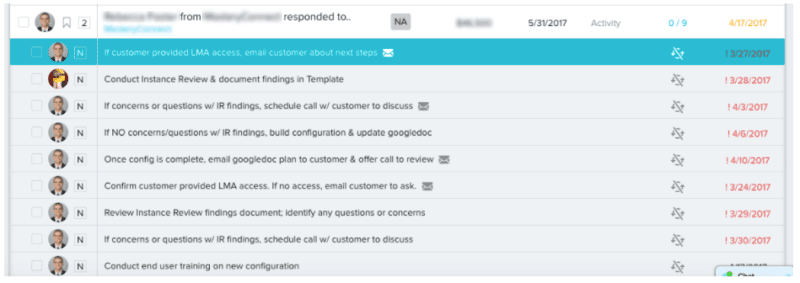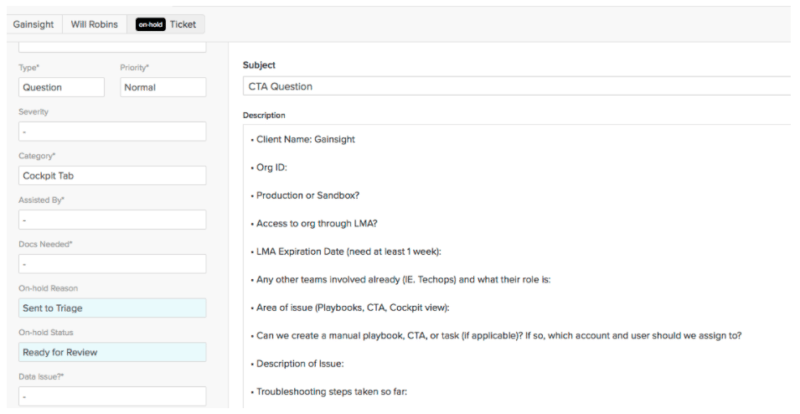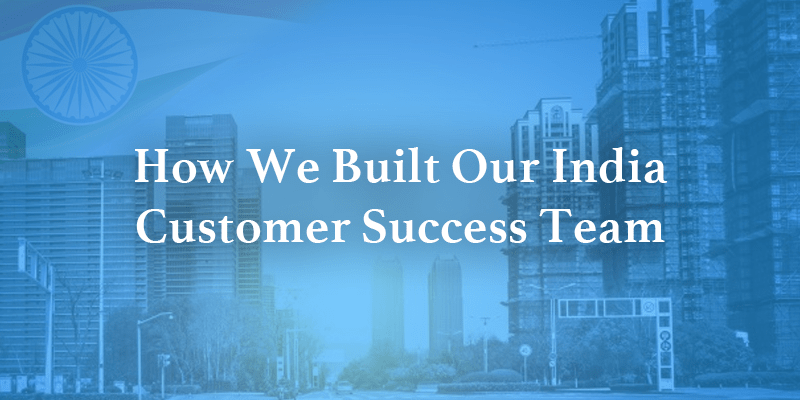Allison Pickens is Chief Customer Officer at Gainsight. Thanks to many Gainsters for building the processes described in this post and contributing to the writing of it – including Sridhar Gollapalli (Director of our Customer Success team in India), Sara Vaughan, Emily McDaniel, Will Robins and Devin Stevens.
As I write this, I’m flying from our Hyderabad, India, office back to the U.S. This week marks 6 months since we hired our first Customer Success team leader there. It’s been 6 months of tremendous learning.
Gainsight has always had an office in India, since our Co-founder and VP of Engineering is based there. Folks sometimes assume that we established an India office to “outsource” or “offshore” work, but that couldn’t be farther from the truth. Essentially all of our product development happens there, 2 offices are there (Hyderabad and Bangalore), and half of our employees are there, supported by a large local management team.
Many tech companies are similarly distributed internationally – increasingly from an early stage. It’s common to hear about co-founders located in multiple countries from the beginning, or a company acquiring another to gain an engineering office abroad. It’s good business to hire the most talented folks, regardless of where they live.
It’s also good business to co-locate part of your Customer Success organization with your engineers. CS benefits from easy access to information on new releases and to help on bugs or the most difficult escalations; Engineering benefits from the feedback and use cases that the CS organization can share.
But most importantly, having a global CS team creates so many new opportunities to deliver great outcomes for customers.
We’re pretty proud of the creativity of our India CS team. At an internal offsite, they hacked our Sponsor Tracking feature in a demo org and turned it into a matchmaking tool for marriages (!).
Besides figuring out how to orchestrate loving relationships (just kidding), here’s what we’ve learned in building our CS team in India.
Make-up of Our Team
As a reminder, here’s what our global CS org structure looks like and here’s how we’ve applied customer segmentation.
The India team has the following functions:
- Onboarding
- Technical Success: Support team and Customer Success Architect (CSA) team
- Business Operations, including Customer Marketing
- Services Operations (soon)
We don’t have Client Outcomes Managers — which is our title for CSMs — in India yet, but we’ll likely change that as our customer base expands globally.
Our Customer Success organization is geographically distributed across Hyderabad; St. Louis, Missouri; San Francisco and Redwood City, California; and other cities in the U.S. where some CSMs are in the field. We span 5 timezones.
This geographic distribution has required us to build smart processes to facilitate collaboration and communication between geographies. Here’s how we built those processes.
Onboarding Team
The India Onboarding team is particularly involved in the configuration of Gainsight, unit testing, and system testing. We align across geos on a common project plan and use certain templates to share the details of the client’s use cases. The goal is flawless transfer of information. We’ll review those templates on calls. We’ve divided up which specific activities are done in the U.S. and which are done in India.
For the speedy onboarding of our SMB customers in particular, we use a Call to Action (CTA) in our own instance of Gainsight that assigns certain activities to the India team members. We track progress as team members check off tasks.

Customer Success Architect Team
The Customer Success Architect (CSA) team is similarly located in both India and the U.S. CSAs offer in-depth technical advice post-onboarding, configuration help, and managed services.
Our India CSA team handles many data-related activities and also runs our Instance Review process. We created a best-practice standard for customer configuration, to demonstrate what each customer should have in their instance to get maximal value from the product. Once we identify a customer who needs their instance updated, the CSA team conducts a review of the instance and then configures what’s required to get them up to par.
To manage instance reviews, the CSAs use Calls to Action in Cockpit. In the screenshot below, you can see that the task deadline indicates when we’ll need the instance review completed. We use Chatter on the CTA to communicate and discuss progress. Using Gainsight, we have a single source of truth for work allocation and priorities across geographies.

Support Team
Having Support teams in both the U.S. and India is hugely beneficial to the client experience, for two central reasons:
- Response time: Our L1 team is split across the U.S. and India, to ensure 24-hour coverage for 5 days per week. We’re now gearing up for 7 days per week. This will mean that the teams will be available to cater to customers’ needs no matter what time zone they’re in or how late they stay up at night.
- Resolution time: Our L2 team is based in India, which allows L1 team members to hand off tricky tickets to L2 at the end of the U.S. work day but rest assured that progress will be made by the India team overnight. During U.S. public holidays, the India team covers for the U.S. team, and vice versa.
Throughout the week, we conduct various team meetings and send out email summaries to ensure everyone across geos is on the same page. These activities include the following:
- Weekly global manager meeting
- Weekly local manager meeting
- Weekly global L1 meeting
- Weekly L2 meeting
- Daily local stand-up to discuss new and hot issues
- Weekly email to summarize known issues from the previous week
- Weekly email to summarize metrics and management escalated tickets
Each sub-team by location has a team lead or manager. This person is the local point of contact for urgent issues and events affecting the team.
Our Support team uses Zendesk as our tracking system to manage collaboration across groups and timezones.
All tickets submitted by customers land in the “Triage” queue. A more experienced team member is assigned to watch the triage queue at all times and assign tickets to the Support agent that’s most likely going to be able to resolve the issue. Once a ticket is picked up by an agent, it generally stays with that agent unless that agent goes out of office or we identify an agent with different expertise is needed to move the ticket to resolution.
If a ticket needs to be escalated to a more technical group, we use a macro that has prompts for the information required by the India-based L2 team in a private comment. These prompts are also helpful for the L2 team because they know exactly what information they are looking at when they open the ticket.

When a ticket is escalated to L2, we keep the ticket assigned to the original agent to continue communicating with the customer, while the L2 team conducts further research behind the scenes. We use fields on the Zendesk ticket to track which phase the ticket is in and who from L2 has been assigned as the owner.
In Zendesk, each team member has multiple views set up to keep track of the tickets they own in various stages. In addition, we have global views for managers to keep a close watch on tickets escalated to L2, tickets that are on the verge of an SLA breach, and tickets that are aging.
Business Operations
Members of our Business Operations team in India drive the administration of our own Gainsight instance and many of our Customer Marketing initiatives.
Our Gainsight Admin in India works closely with U.S. team members (across many departments) to set up configurations and processes. She is also well positioned to work closely with our Product and Engineering teams, since she works right next to them. She’s able to share real-world use cases for Gainsight features with Product and Engineering, while having the best foresight into upcoming features and enhancements that could benefit customers.
Our Customer Marketing Analyst in Hyderabad creates customer case studies, coordinates sales references, manages our Influitive hub, and quarterbacks many other advocacy initiatives. Combined with our content creation effort in the U.S., we’re producing collateral for our Sales, Marketing, and CSM teams around the clock.
General Communication
As much as possible, we aim to empower team members to travel from the U.S. to India and vice versa. This helps teams understand the culture and communication style of different offices. One of the typical challenges we encounter during face-to-face communication is confusion over the meaning of head nods. This tends to elicit a lot of laughs in both geos 🙂 For U.S. folks: if you don’t know what we mean, our India Customer Success team leader Sridhar recommends that you check out this video.
We also have a biweekly meeting between Sridhar and the other Customer Success department leaders. The agenda typically includes:
- Report and share status of work. Call out any risks that impact the milestones
- Discuss upcoming work
- Discuss strategic initiatives to drive faster implementations
- Discuss process improvements to collaborate better
If you’d like to use Gainsight to ensure better collaboration across your geographically dispersed teams, contact your Gainsight CSM.

